|
A very interesting academic paper was written several years ago by National Master Dr. Noam Elkies, a Professor of Mathematics at Harvard University (world-class problemist). For those in math and computer science, "combinatorics" is known as an esoteric subject dealing with probabilistic counting, graphology and set theory. Not straightforward by any means!
Elkies wrote a paper titled, "On Numbers and Endgames: Combinatorial Game Theory in Chess Endgames," which attempts to dissect endgames in combinatorial problems, or combinatorial game theory (CGT). He focuses primarily on positions where "mutual zugzwang" is possible, but does so by looking at the chess board in subgames. He writes,
"To find interesting CGT aspects of chess we look to the endgame. With most or all of the long-range pieces no longer on the board, there is enough room for a decomposition into several independent subgames. Also, it is easier to construct mutual Zugzwang positions in the endgame because there are fewer pieces that could make neutral moves; indeed it is only in the endgame that mutual Zugzwang ever occurs in actual play. If a mutual Zugzwang is sufficiently localized on the chessboard, one may add a configuration of opposing pawns that must eventually black each other, and the first player who has no move on that configuration loses the Zugzwang."
Mutual zugzwang has been presented at this site by IM-elect Stephen Muhammad, but this novel way of counting may have application in a actual play. Many players learn counting methods and use geometric guides for endgame play. While this paper may not be readable to all, the examples are certainly understandable and instructive. Take the following position:
|
|

